Compare 5 Leading EHR Companies: Features, Benefits, and More

Compare 5 Leading EHR Companies: Features, Benefits, and More
Overview
The article provides a comprehensive comparison of five leading Electronic Health Record (EHR) companies, focusing on their features, benefits, and market positions. By examining key aspects such as:
- Interoperability
- User-friendly interfaces
- Telehealth integration
- Data analytics
it sheds light on how these systems can significantly enhance healthcare delivery. These features not only improve patient care but also boost operational efficiency. Consequently, healthcare organizations can utilize these insights to select the most suitable EHR system tailored to their specific needs.
How can these advancements in EHR technology transform your practice? Understanding these elements is crucial for making informed decisions in today's evolving healthcare landscape.
Introduction
The landscape of healthcare is undergoing a rapid transformation, prominently featuring Electronic Health Records (EHRs) as pivotal elements of this evolution. These digital systems not only streamline patient data management but also enhance care coordination and clinical decision-making, presenting a compelling case for their widespread adoption.
However, with numerous EHR companies competing for attention, how can healthcare providers discern which solution best meets their unique needs?
This article delves into a comparative analysis of five leading EHR companies, exploring their features, advantages, and benefits, to guide organizations in making informed decisions that can significantly impact patient care and operational efficiency.
Understanding Electronic Health Records (EHRs)
Electronic Health Records (EHRs) serve as digital counterparts to traditional paper charts, designed to enhance the collection, storage, and sharing of individual information. By providing extensive access to client data, EHRs significantly improve care coordination and clinical decision-making. Over time, EHR systems have evolved remarkably, shifting from basic record-keeping tools to sophisticated platforms that integrate functionalities such as billing, scheduling, and telehealth. This evolution is driven by the increasing demand for effective medical service delivery and the complexities of modern care management.
The influence of EHRs on medical service delivery is substantial. For instance, a family medicine practice that implemented EHRs alongside telehealth services reported a 60% increase in client access through virtual visits and a 30% reduction in no-show rates, resulting in an additional $75,000 in revenue. Furthermore, EHRs facilitate seamless communication among healthcare professionals, which is essential for reducing clinical errors and enhancing patient safety. Data indicates that practices utilizing EHRs typically achieve a return on investment of around $86,400 per provider over five years, highlighting their financial viability.
Nonetheless, the adoption of EHRs presents challenges. Issues such as interoperability, data security, and provider burnout remain significant hurdles that healthcare organizations must address to fully leverage the potential of EHRs in enhancing care and outcomes. As EHR systems continue to advance, there is a growing emphasis on user engagement and personalized care. Future iterations are expected to prioritize seamless data transfer, enabling healthcare providers to access individual information across various platforms effortlessly. This transition not only improves the quality of care but also empowers patients to take an active role in managing their health, ultimately leading to better health outcomes.
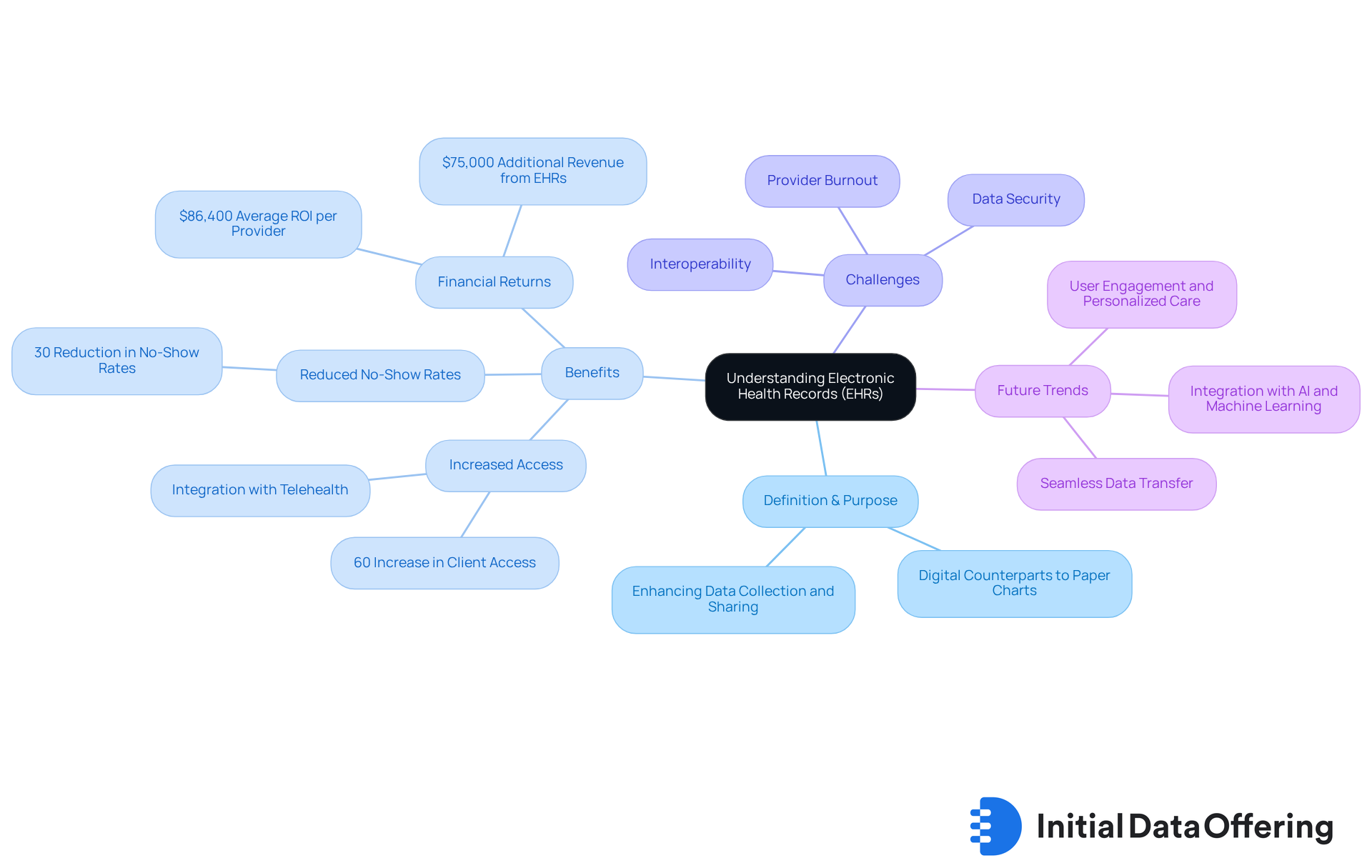
Key Features of Leading EHR Systems
Prominent EHR companies, such as Epic, Oracle Health (formerly Cerner), and eClinicalWorks, offer a range of features tailored to various medical environments. These features are essential for enhancing healthcare delivery and operational efficiency.
-
Interoperability stands out as a critical feature, allowing for seamless data sharing across different healthcare systems. This capability is vital for improving care coordination, as it minimizes duplication of efforts and fosters collaboration among medical teams. As industry specialists emphasize, "The top EHRs will enable you to monitor, chart, and analyze clinical parameters on any individual or group and then present clinical data for Quality Reporting."
-
Another key feature is User-Friendly Interfaces. Intuitive designs greatly enhance usability for healthcare providers, saving time and reducing the risk of errors. For example, Praxis EMR has been rated #1 by major platforms for its usability, underscoring the importance of user-friendly design in boosting clinical efficiency and provider satisfaction.
-
Telehealth Integration has gained significant importance, especially in recent times. This feature supports virtual consultations, which enhance access to care and reduce wait times. Moreover, it strengthens individual engagement through real-time updates and secure communication. The integration of EHR software with telehealth has proven to be crucial, particularly during the COVID-19 pandemic, facilitating the rapid adoption of telemedicine.
-
The availability of Data Analytics tools empowers healthcare organizations to analyze patient data effectively. These capabilities allow providers to track, graph, and trend clinical parameters, which supports quality reporting and performance improvement initiatives. User satisfaction ratings indicate that solutions incorporating advanced data analytics are more likely to enhance operational efficiency.
-
Lastly, Customizable Workflows offer the flexibility needed to adapt EHR systems to specific practice needs. This adaptability is essential for practices aiming to optimize their operations and improve overall efficiency. By tailoring workflows, providers can ensure that their systems align with their unique operational processes.
In summary, these features not only enhance individual patient care but also streamline administrative processes, making them indispensable for EHR companies striving for excellence.
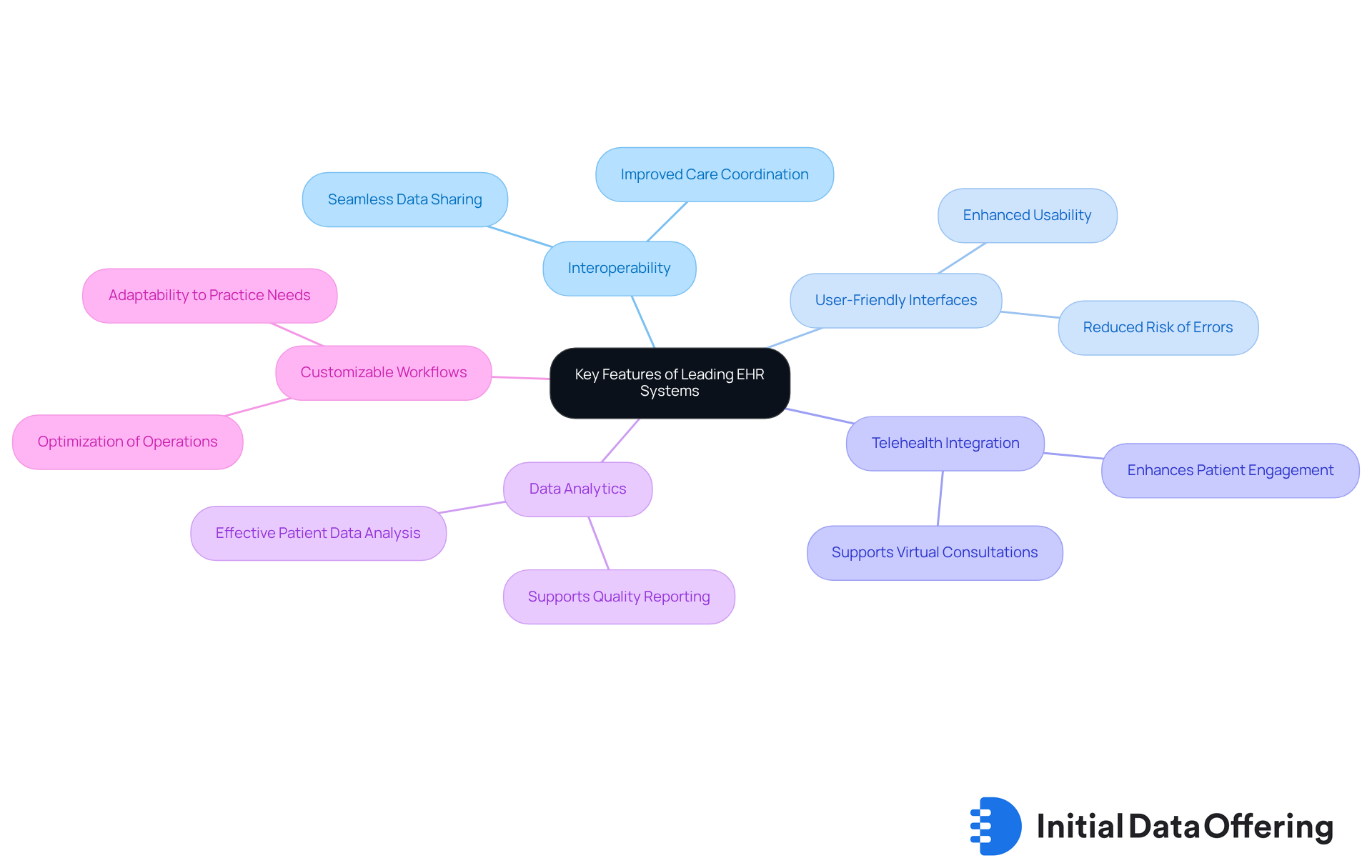
Benefits of Implementing EHR Solutions
Implementing EHR solutions offers numerous benefits, which can be highlighted through the following features, advantages, and benefits:
-
Improved Patient Care: EHRs provide healthcare providers with immediate access to comprehensive patient histories, which enables better-informed clinical decisions. Research indicates that 78% of doctors using electronic health records noted improved care overall. Notably, those employing platforms that satisfy Meaningful Use standards are 9.9 percentage points more likely to report such enhancements. Furthermore, doctors with two or more years of EHR experience were 25.4 percentage points more likely to report improved care, underscoring the importance of experience in effectively utilizing EHR capabilities.
-
Enhanced Efficiency: The automation of administrative tasks significantly reduces paperwork and streamlines workflows. This allows providers to dedicate more time to patient care, with nearly 90% of office-based physicians currently utilizing ehr companies to streamline appointment scheduling and minimize errors such as double booking. Additionally, EHRs help prevent human errors, such as indecipherable handwriting or misplaced paperwork, further illustrating the efficiency gains associated with these systems.
-
Better Data Management: EHRs enhance the organization and retrieval of individual data, resulting in improved accuracy and a reduction in errors. For instance, 65% of EHR users reported that their platforms warned them of possible medication mistakes, thereby enhancing safety for individuals. Moreover, 62% of EHR adopters were notified of critical lab values, demonstrating how EHRs contribute to improved data management and safety for patients.
-
Regulatory Compliance: EHR platforms assist medical organizations in fulfilling regulatory obligations by ensuring that patient data is securely stored and readily accessible. The 21st Century Cures Act has established norms for sharing electronic health information, promoting transparency and compliance. In this context, ehr companies play a critical role in maintaining these standards by facilitating secure data management practices.
-
Cost Savings: Over time, EHRs can lead to significant cost reductions by minimizing administrative burdens and improving operational efficiencies. The transition to EHRs is anticipated to save the medical sector billions each year by decreasing medical errors and optimizing processes, ultimately contributing to a favorable return on investment. EHR systems can yield long-term savings by reducing reliance on paper-based systems and minimizing medical errors, which is particularly relevant given that the financial impact of medical errors costs the medical sector approximately $20 billion each year.
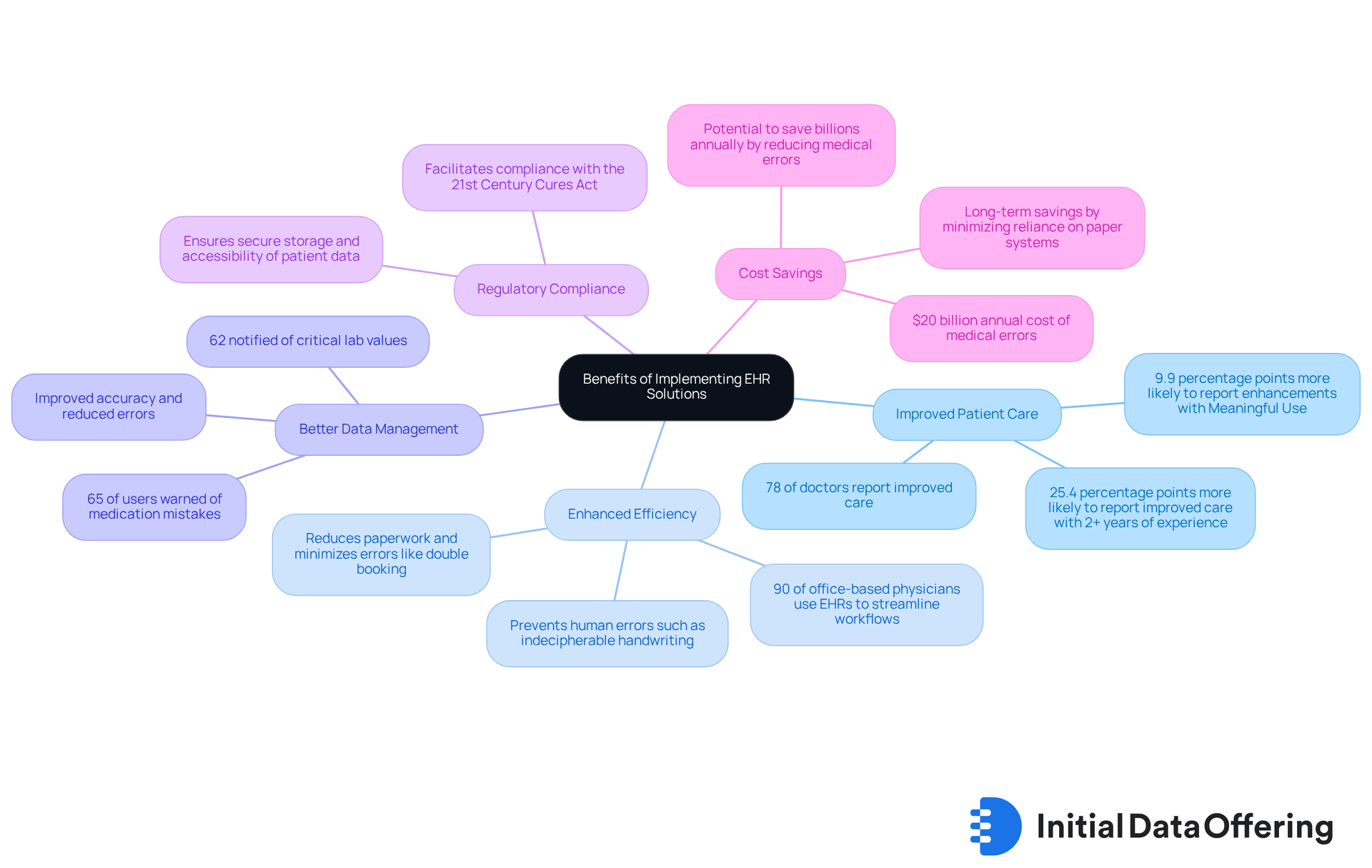
Market Position of Top EHR Companies
The EHR companies in the market are characterized by several key players, each contributing unique strengths to the table.
- Epic Systems stands out with a significant market share, recognized for its comprehensive solutions designed specifically for large healthcare organizations. This focus enables Epic to cater effectively to the complex needs of these institutions.
- Oracle Health (Cerner) is another major player in the enterprise EHR space, emphasizing the integration of advanced technologies such as AI and cloud computing. This commitment to innovation allows Cerner to enhance operational efficiency and improve patient outcomes.
- eClinicalWorks has gained popularity among small to mid-sized practices, offering a user-friendly interface paired with robust telehealth capabilities. This combination supports healthcare providers in delivering accessible care to their patients.
- MEDITECH is particularly recognized for its dedication to community hospitals, providing customizable solutions that address specific medical needs. This adaptability ensures that local healthcare facilities can meet the diverse requirements of their patient populations.
- Allscripts presents a range of EHR solutions with a strong emphasis on interoperability and data analytics. This focus empowers healthcare organizations to leverage their data for better decision-making and improved patient care.
These EHR companies are in a constant state of innovation, striving to maintain their competitive advantage by addressing the evolving needs of medical providers and patients alike. How might these advancements impact your practice or organization? Consider the implications of adopting such technologies and the potential benefits they could bring.
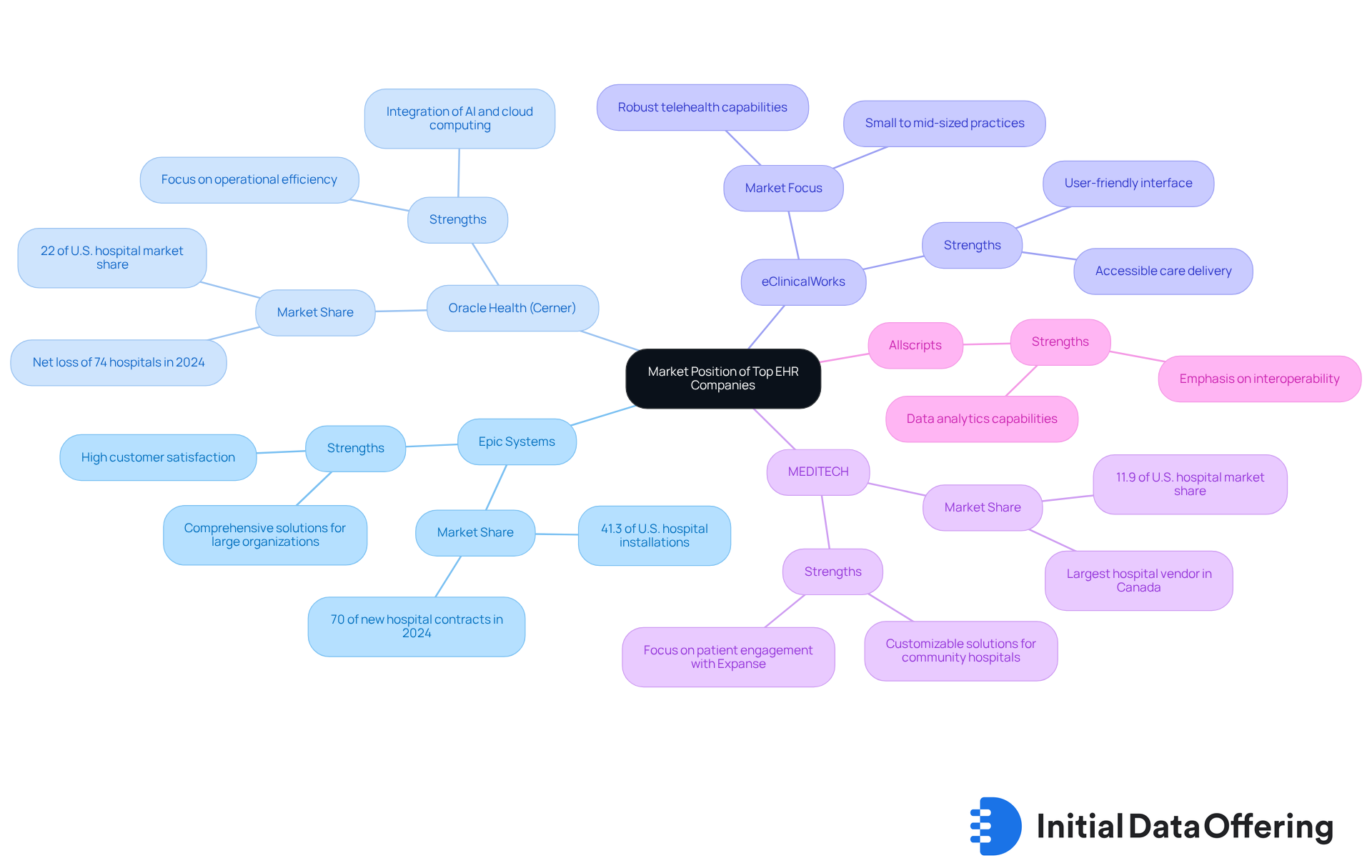
Comparative Summary: Choosing the Right EHR System
Selecting the appropriate EHR system necessitates a thorough evaluation of several key factors:
-
Practice Size and Specialty: Larger healthcare organizations often benefit from comprehensive systems like Epic, which offer extensive functionalities and interoperability. In contrast, smaller practices may find user-friendly options such as eClinicalWorks more suitable, as they provide essential features without overwhelming complexity.
-
Budget Considerations: Cost is a pivotal factor in EHR selection. Organizations should analyze both upfront expenses and ongoing subscription costs, which typically range from $150 to $1,100 per provider per month. Understanding the total cost of ownership, including maintenance fees and potential return on investment, is crucial for justifying the investment.
-
Feature Requirements: Identifying essential features tailored to the practice's needs is vital. This may include telehealth capabilities, e-prescribing, and advanced data analytics. A clear ranking of these features can guide the selection process effectively.
-
Vendor Support and Training: The level of support and training offered by the vendor can significantly influence the success of the implementation. Organizations should seek vendors that provide robust training programs and ongoing support, as well as internal training to facilitate a smooth transition and enhance user proficiency.
-
Interoperability Needs: Ensuring that the chosen EHR solution can integrate seamlessly with other software platforms is essential for maintaining efficient workflows. Organizations should consult vendors regarding the interfaces they utilize and their compatibility with current frameworks, as interoperability is a primary focus of government guidelines.
By meticulously considering these factors, healthcare organizations can choose an EHR system from ehr companies that not only aligns with their operational goals but also enhances patient care and overall efficiency.
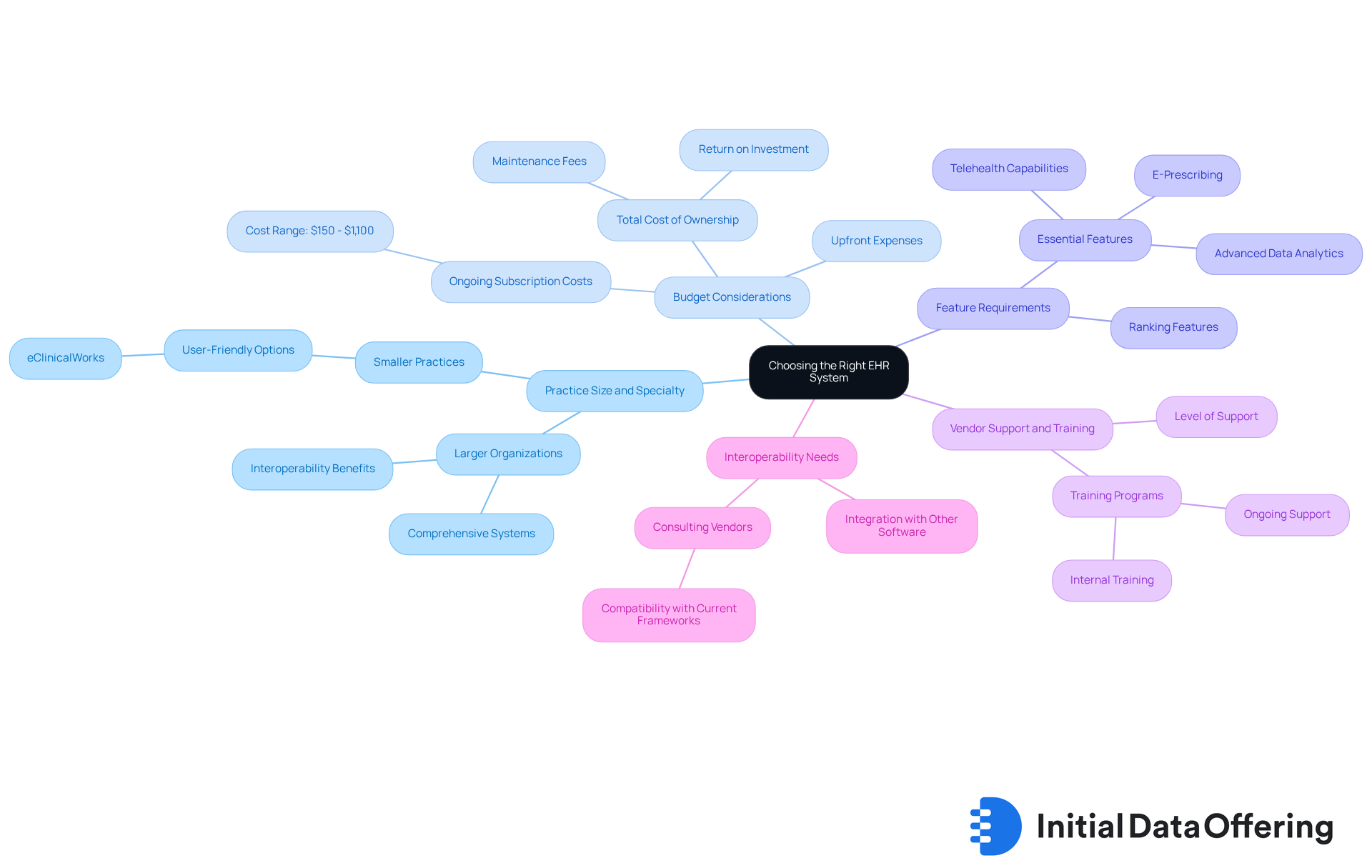
Conclusion
The evolution of Electronic Health Records (EHRs) has transformed them into indispensable tools for modern healthcare, enhancing the way patient information is collected, stored, and shared. By streamlining processes and facilitating better care coordination, EHR systems not only improve clinical decision-making but also empower healthcare providers to deliver more effective patient care. The advancements in EHR technology underscore their critical role in the healthcare landscape, making it essential for organizations to adopt systems that align with their unique needs.
Throughout the article, key features of leading EHR systems were examined, including:
- Interoperability
- User-friendly interfaces
- Telehealth integration
- Data analytics
- Customizable workflows
These elements are crucial for enhancing operational efficiency and patient engagement. The benefits of implementing EHR solutions—such as improved patient care, enhanced efficiency, better data management, regulatory compliance, and cost savings—demonstrate their value in driving positive outcomes for healthcare organizations.
In light of the insights presented, it is clear that selecting the right EHR system is a strategic decision that requires careful consideration of:
- Practice size
- Budget
- Feature requirements
- Vendor support
- Interoperability needs
As healthcare continues to evolve, embracing the capabilities of leading EHR companies will not only optimize operational processes but also significantly improve patient care. Organizations are encouraged to evaluate their options meticulously and take decisive steps toward integrating EHR solutions that will lead to better health outcomes and a more efficient healthcare system overall.
Frequently Asked Questions
What are Electronic Health Records (EHRs)?
Electronic Health Records (EHRs) are digital versions of traditional paper charts that enhance the collection, storage, and sharing of individual health information, improving care coordination and clinical decision-making.
How have EHR systems evolved over time?
EHR systems have evolved from basic record-keeping tools to sophisticated platforms that integrate functionalities such as billing, scheduling, and telehealth, driven by the demand for effective medical service delivery and modern care management complexities.
What impact do EHRs have on medical service delivery?
EHRs significantly improve medical service delivery by increasing client access through virtual visits, reducing no-show rates, facilitating communication among healthcare professionals, and enhancing patient safety, leading to better financial outcomes for practices.
What are some challenges associated with EHR adoption?
Challenges in EHR adoption include interoperability issues, data security concerns, and provider burnout, which healthcare organizations must address to fully leverage EHRs' potential.
What features are essential in leading EHR systems?
Key features of leading EHR systems include interoperability for seamless data sharing, user-friendly interfaces for enhanced usability, telehealth integration for virtual consultations, data analytics tools for effective patient data analysis, and customizable workflows to adapt to specific practice needs.
Why is interoperability important in EHR systems?
Interoperability is crucial as it allows for seamless data sharing across different healthcare systems, improving care coordination and minimizing duplication of efforts among medical teams.
How does telehealth integration benefit EHR systems?
Telehealth integration enhances access to care, reduces wait times, and strengthens patient engagement through real-time updates and secure communication, especially important during the COVID-19 pandemic.
What role do data analytics tools play in EHR systems?
Data analytics tools empower healthcare organizations to analyze patient data effectively, track clinical parameters, and support quality reporting and performance improvement initiatives.
How do customizable workflows enhance EHR systems?
Customizable workflows provide the flexibility needed for practices to adapt EHR systems to their specific operational needs, optimizing operations and improving overall efficiency.